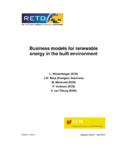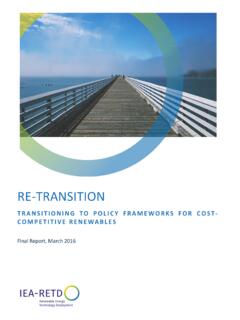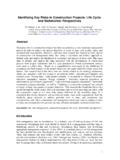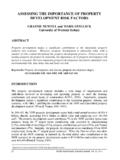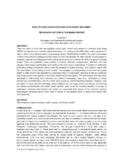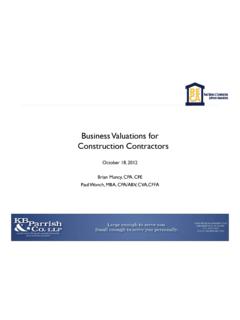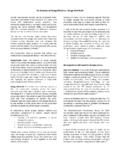Transcription of Risk Quantification and Risk Management in …
1 It must not be partially or totally reproduced without permission of Altran GmbH & Co. KG or IEA - RETD. Risk Quantification and Risk Management in Renewable Energy Projects Risk Quantification and Risk Management in Renewable Energy Projects 2 Risk Quantification and Risk Management in Renewable Energy Projects This report was commissioned by the IEA Renewable Energy Technology Deployment. Authors: Altran Italy Jean Michelez Nicola Rossi Altran Spain Rosario Blazquez Juan Manuel Martin Emilio Mera Altran Netherlands Dana Christensen Christian Peineke Altran Germany Konstantin Graf Arthur D. Little David Lyon Geoff Stevens Acknowledgments: David de Jager IEA-RETD Operating Agent, Louis Fananas Deutsche Bank, Eduardo Foz BP Solar,Carlos Montoya IDEA, David Jack Lux Energia Solar, Rafael Luna Naturener Solar, Jorge Castano Sunpower, Juan Carlos Sirviente Naturener Solar, Antonio de la Torre Abengoa Solar, Florian Klein Abengoa Solar, Van Gansewinkel Henk Eneco, Bos Tiemen Jan Eneco, Horst Max EWT, Buddenbaum Ed EZ (regulator), Jongkind Anne Nuon/Weom, Jongste Niels Green Giraffe, Stefan Hochbruck Bard Offshore Created: Checked: Approved: Released: Name: see above Name: Jean Michelez, David Lyon, Emilio Mera Name: David de Jager Name: IEA-RETD Contact: Altran GmbH & Co.
2 KG Konstantin Graf Veritaskai 3 21079 Hamburg Germany +49 (0) 40 797156-0 Risk Quantification and Risk Management in Renewable Energy Projects 3 This document has been prepared for the titled project should not be relied upon or used for any other project without an independent check being carried out as to its suitability and prior written authority of Altran or the IEA-RETD being obtained. Altran accepts no responsibility or liability for the consequence of this document being used for a purpose other than the purposes for which it was commissioned. Any person using or relying on the document for such other purpose agrees, and will by such use or reliance be taken to confirm his agreement to indemnify Altran for all loss or damage resulting there from. Altran accepts no responsibility or liability for this document to any party other than the person by whom it was commissioned. To the extent that this document is based on information supplied by other parties, Altran accepts no liability for any loss or damage suffered by the client, whether contractual or tortuous, stemming from any conclusions based on data supplied by parties other than Altran and used by Altran in preparing this document.
3 Risk Quantification and Risk Management in Renewable Energy Projects 4 Table of content Page 1 Introduction .. 10 The Study .. 10 Report Structure .. 11 Report rationale: Challenges for Renewable Energy Projects .. 12 2 Conventional energy projects and related uncertainties .. 17 risks associated with conventional energy projects .. 17 Risk Management Approach in Energy Projects .. 25 Objectives of project Risk Management Approach .. 25 3 Uncertainties in RES investments .. 29 RES project Characteristics .. 30 risks associated with specific RES technologies .. 32 Solar Thermal technologies .. 34 Photovoltaic Technologies .. 38 Biomass Technologies .. 40 Wind Energy .. 44 Geothermal Plants .. 46 Wave and tidal stream devices .. 47 Tidal barrages and lagoons .. 48 4 Recommended Risk Management Methodology in Renewable Energy Projects .. 50 project Definition and Requirements .. 51 Risk Identification.
4 53 Risk Identification techniques .. 53 Risk Breakdown Structure .. 56 Risk Register .. 58 Check for Risk Identification: Consistency and Completeness .. 59 Risk Evaluation .. 60 Qualitative Risk Evaluation .. 61 Quantitative Risk Evaluation .. 63 Risk Control .. 74 Risk Follow-up .. 80 Risk Feedback .. 83 Risk Management Implementation in RES investment lifecycle .. 84 5 Definition and assessment of support measures .. 87 Introduction .. 87 Measures to address political risks .. 88 Measures to address economic risks .. 90 Measures to address social risks .. 94 Measures to address technical risks .. 95 Generic interventions .. 97 Conclusions and outstanding barriers .. 98 6 Conclusions and recommendations .. 99 Risk Quantification and Risk Management in Renewable Energy Projects 5 Conclusions .. 99 Recommendations for innovative support measures .. 105 7 List of Figures and Tables .. 108 8 References .. 111 9 Annexes .. 114 Annex 1 Case Studies and Feedback from REN Players.
5 114 Annex 2 Background to Altran, Arthur D. Little and RETD .. 145 10 Glossary .. 146 Risk Quantification and Risk Management in Renewable Energy Projects 6 Executive summary: Risk Quantification and Risk Management in Renewable Energy Projects Renewable energy plays an important role in the transition towards a low carbon economy and the provision of a secure supply of energy. Many years of research and development have brought a number of renewable energy technologies to a stage where they are technologically mature and ready for a more widespread market introduction. However, perceptions of the associated risks have constrained the progress of renewable energy; as a consequence there is still a gap between Renewable Energy Systems (RES)1 promoters and financing organizations: Venture capital and project finance gap. The further development of renewable energy projects is restricted by the challenge of bridging the technology development and scale-up gap.
6 This reflects the very different requirements of Venture Capital (VC) investing in emerging technology, and project finance supporting established technologies (often supported by a stable regulatory regime). Availability of venture capital to sustain emerging technologies. Emerging technologies ( wave and tidal) need to raise working capital for both sustaining the operations of technology companies as well as the demonstration projects. Markets now recognize the high capital, high risk, long lead time involved with these technologies; unless venture capital firms are following their own previous investments, they are now pulling away altogether. A key challenge in obtaining financing at a reasonable cost is the ability to quantify and manage the different elements of risk ( organizational, political, technical, commercial) associated with RES projects. This project commissioned by the International Energy Agency and conducted by Altran and Arthur D. Little provides reproducible and transparent techniques to assess the risk/return profiles of RES investments.
7 In doing so, the project provides RES-specific guidelines in classification, assessment and Management of different risk elements associated to support project valuation. Conventional energy projects have been developing and refining methodologies for risk assessment for many years. The project considers the lessons learnt in detail in order to understand what is transferable to RES projects. Using specific RES project case studies and involving conventional energy, RES and risk Management experts, the project has resulted in a methodology applicable for RES projects. The methodology is broken down into a number of key (and established) elements: Figure 1 Generic project Risk Management Process 1 In this document renewable energy sources and technologies will be referred to as RES. Risk Quantification and Risk Management in Renewable Energy Projects 7 Risk Management methodologies can (and should) be the same between RES and conventional energy projects.
8 In particular, any RES project risk Management approach should structure and apply a conscious approach to risk identification, risk appraisal, risk handling and risk review. The key is to be able to tailor the complexity of the risk analysis and associated Management processes to the size and nature of the projects. An important requirement is to avoid oversizing risk assessment and to avoid introducing low value complexity. 1. project definition and requirements: The first step requires a detailed description of the context in which the analysis is carried out. project descriptions of RES projects are likely to differ from conventional projects in a number of key areas: Technologies such as wind, PV are much more modular than other types of projects. Where grid connection and other enabling construction costs are lower ( PV), the investment critical mass is lower and capability for plant growth is higher. RES projects can include less mature technologies where technical standards have not been developed.
9 These projects follow a very different logic to purely commercial projects ( for a demonstrator project the performance is more important than build time, hence delay might be acceptable). Compared to other infrastructure projects, RES technologies (with the exception of biomass and biofuels) have relatively low O&M costs compared to up-front investment. There are complex permitting processes which need to be described. This includes administrations at different levels and for different matters ( planning, environmental permits, subsidy permits, and grid connections). Specific issues associated with dispatchability have to be documented carefully. This applies to technologies such as wave, wind or PV, but not to tidal or biomass/biofuels. Given the incapacity to store and/or forecast energy generated with the same accuracy as other conventional generation technologies, renewable energies are often much more sensitive to the supply-demand balance in the grid.
10 All RES projects are based on a distributed generation model. Therefore the project description should describe the operational model of utilities (which can be much more complex than with conventional generation). Given the limited sources for finance of smaller RES projects (compared to conventional energy projects) and the limited commercial background of sponsors, these need to be documented carefully. project finance and its associated fee structure requires projects sufficiently large to support the fees with sufficient cash flow to justify modest interest rates. Venture capital could absorb the higher risk but requires higher returns which are not compatible with taxpayer subsidised schemes. 2. Risk identification involves ensuring all key topics are considered, and lessons learnt from past projects are incorporated. In practice this process is improved by the use of a Risk Breakdown Structure (using a structured approach to list risks that could be encountered), the use of a facilitated workshop and the drawing from risk libraries based on past experiences.

